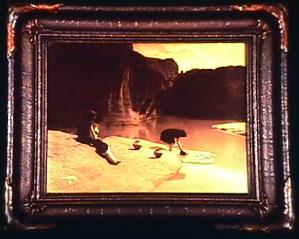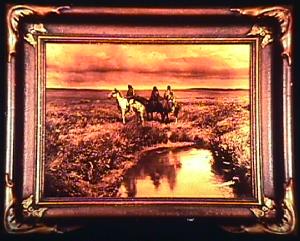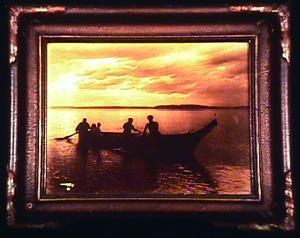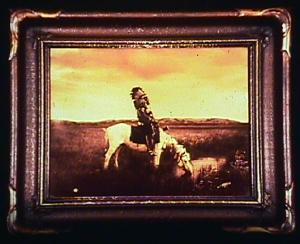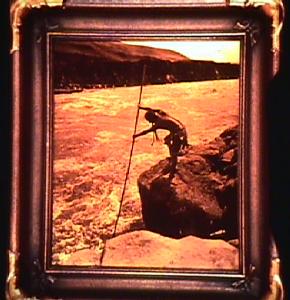'Curt-Tones' The Goldtones of Edward S. Curtis
By: Raymond H. Kirlin, Seattle
Photography By: Darrel Womack, Seattle
Early in 1900 a Seattle photographer set out to compile a legacy of photographs of the North American Indian, an undertaking that would require almost a lifetime and would cover some 80 tribes on the North American Continent. Such a task was close to impossible except for a man with conviction and perseverance. Such a man was Edward S. Curtis, who would dedicate his life to recording the lives and the customs of these people he so truly loved. The result was an incredible 40,000 photographs of which 2200 images were used for reproduction. Each is a masterpiece in natural lighting and composition showing the American Indian in his own invironment. The American Indian loved the land, the land was their way of life and Curtis documented this by learning their customs and their life styles through actually living with these noble people. The result of Curtis's accomplishments are published in an issue of 20 volumes and 20 portfolios printed on the finest of vellum, holland paper, and tissue, all bound in fine rich brown Morrocan leather. These works, known as "The North American Indian", were not completed until 1930.
During the nearly 30 years it took to complete his task, Curtis was constantly troubled by lack of funds. During this time, in order to obtain the necessary funds, Curtis maintained a Seattle Studio close to the Olympic Hotel. From this location he sold prints of selected photographs along with a normal business of portrait, wedding and commercial photography. It was in the Seattle studios that he developed the techniques of making photographs on glass that he named "Curt-tones". His technique was a variation of the Orotone process popular at that time. The resulting photographic prints have, through common usage, become known as "Goldtones". There were many photographers who used the goldtone process and their photographs are often mistakenly thought to be Curtis Goldtones by virtue of the fact that it was he who popularized that style of photography. However, each photographer developed his own process and techniques and these were kept highly secret. These techniques today are considered a lost art. Modern duplications and copies can be detected by those expert or knowledgable in this art.
In 1920 prior to his completion of the North American Indian volumes, Curtis suffered ill health which combined with other problems prompted him to leave the Pacific Northwest and settle in California. In the Los Angeles area he continued his photography in partership with his daughter Beth Curtis Magnuson and his son-in-law Manford E. Magnuson. From this studio came many of Curtis's goldtones marked with LA under his signature.
Edward Curtis died in 1952 without having fully enjoyed the acclaim and financial benefit that resulted from his outstanding accomplishments. His original Curt-tones sold for:
Size 8x10, framed $10.00
Size 11x14, framed $15.00
Size 14x17, framed $30.00
Size 18x22, framed $50.00
Today they sell for prices of $1,000 to $3,000 with certain rare photographs selling for even more. The photographs on platinum paper or certain photogravure prints may run as high as $4,500 or more for an extremely rare example. There have been uncomfirmed reports of figures several times that high. Prices vary in different areas of the country and both the buyer and the seller should be aware of the many reproductions and copies that are on the market.
The author of this article has been a long time collector and interested primarily in the original photographs and Curt-tones made and signed by Curtis. These were made on Cyanotype paper, silver paper, platinum paper, and 'goldtone' glass plates.
Cyanotypes were used by Curtis in the field to check the quality and composition of his negatives. This could be called proofing and as such they are considered to be one of a kind. Cyanotypes currently do not command the high prices of the platinum prints but due to the nature of their original use they are far more rare. They can be easily identified because they look like a photograph printed on blue print paper. The paper is quite thin and the contact print is the exact size of the original negative.
The silver prints were made on paper sensitized with an emulsion containing silver salts, usually silver bromide, iodide or chloride. After developing they nere carefully toned to bring out and enhance the subtle tones of Curtis's prints and to make the prints more permanent. They normally ranged in size from 4 1/2x6 prints to enormous 30x40 prints with the majority of them framed in dark oak frames. Quite frequently the smaller prints were double printed to give a border effect.
The Platinum prints are made on paper impregnated with platinum salts. The salts are not contained in an emulsion or coating, but are impregnated in the fibers of the papers giving a depth to the print unattainable with emulsion coated papers. Platinum prints are more permanent and not as susceptible to fading and moisture as bromide prints. Development could be controlled to provide warm brown tones to deep black browns.
The Goldtones, which Edward S. Curtis named the Curt-tones are enlarged photographs printed on a specially sensitized glass called Seed Dry Plates, manufactured by Eastman Kodak Company. After development they were toned in a gold toning solution and then backed on the emulsion side with a fine gold powder in a specially prepared vehicle. The brilliance of the gold reflecting through the print gave the Curt-tone an aura unmatched by any other photographic process. Eagerly sought after by collectors, they command premium prices depending on size, condition and subject matter. Potential purchasers or owners should be aware of defects which can reduce the value. These defects include lack of brilliance, rub marks, scratches, too dark or too light, lack of Curtis studio label & description on the back, and very important, the loss of the original frame or damage to the frame. Curt-tones should always be purchased in their original frame with the original back and they should be signed with the [example signature] signature. Some contain LA under the signature, which, as mentioned before, indicates that they were made in the Curtis Studio in Los Angeles.
If you have certain questions, need additional information or know of prints for sale you may write the author of this article c/o Box 48099, Seattle, Washington, 98166. Please enclose a self addressed and stamped envelope. Those interested in historical and accurate information on Edward S. Curtis and his life may refer to: Edward Sheriff Curtis Visions of a Vanishing Race and Edward S. Curtis, Photographer of the North American Indian. Both written by Curtis's daughter, Florence Curtis Graybill and Victor Boesen.
